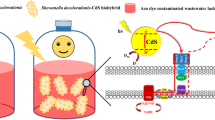Abstract
In this study, a functional bio-carrier modified by redox meditors was developed as a redox mediator for application in azo dye decolorization processes. Its accelerating effect and mechanism for azo dyes decolorization were also examined. The decolorization rates of 10 azo dyes were enhanced about 1.5–3 fold by the functional bio-carrier modified with disperse turquoise blue S-GL, and the ORP value during the acid red GR decolorization process was changed to a more negative value of 20–25 mV. Non-dissolved redox mediator on the functional bio-carrier played a similar role as NADH during the azo dyes decolorization process. At the same time, the functional bio-carrier exhibited good reusability and the combinational technology of the redox mediator and bio-carrier was a great improvement of the redox mediator application and represents a new bio-treatment concept.








Similar content being viewed by others
References
Bourbonnais R, Leech D, Paice MG (1998) Electrochemical analysis of the interaction of laccase with lignin model compounds. Biochim Biophys Acta 1379:381–390
Cervantes FJ (2002) Quinones as electron acceptors and redox mediators for the anaerobic biotransformation of priority pollutants. Ph.D., Wageningen University, Wageningen, The Netherlands
Delée W, O’Neill C, Hawkes FR, Pinheiro HM (1998) Anaerobic treatment of textile effluents: a review. J Chem Technol Biotechnol 73(4):323–335
Dos Santos AB, Cervantes FJ, Van Lier JB (2004) Azo dye reduction by thermophilic anaerobic granular sludge, and the impact of the redoxmediator anthraquinone-2,6-disulfonate (AQDS) on the reductive biochemical transformation. Appl Microbiol Biotechnol 64:62–69
Dos Santos AB, Cervantes FJ, van Lier JB (2007) Review paper on current technologies for decolourisation of textile wastewaters: perspectives for anaerobic biotechnology. Bioresour Technol 98:2369–2385
Field JA, Cervantes FJ (2005) Microbial redox reactions mediated by humus and structurally related quinones. In: Perminova IV, Hatfield K, Hertkorn N (eds) Use of humic substances to remediate polluted environments: from theory to practice, vol 52. Springer, Dordrecht; The Netherlands, pp 343–352
Guo J, Zhou J, Wang D, Tian C, Wang P, Salah Uddina M, Yu H (2007) Biocalalyst effects of immobilized anthraquinone on the anaerobic reduction of azo dyes by the salt-tolerant bacteria. Water Res 41(2):426–432
Guo J, Zhou J, Wang D, Yang J, Li Z (2008) The new incorporation biotreatment technology of bromoamine acid and azo dyes wastewaters under high salt conditions. Biodegradation 19:15–19
Guo J, Zhang L, Yang J, Hong Y, Liu C, Li Z, Wang X, Kang L (2009) Isolation and characteristic of an azo dye-decolorizing salt-tolerant bacteria strain GYW. Microbiol Lett 36(4):1–8
Kudlich M, Keck A, Klein J (1997) Localization of the enzyme system involved in anaerobic reduction of azo yes by Sphingomonas sp. Strain BN6 and effect of artificial redox mediators on the rate of azo dye reduction. Appl Environ Microbiol 63:3691–3694
Li L, Zhou J, Wang J, Yang F, Jin C, Zhang G (2009) Anaerobic biotransformation of azo dye using polypyrrole/anthraquinonedisulphonate modified active carbon felt as a novel immobilized redox mediator. Sep Purif Technol 66:375–382
Markwell MA, Hass SM, Buber L, Tolbert NE (1978) A modification of the Lowry procedure to simplify protein determination in membrane and lipoprotein samples. Anal Biochem 87:206–210
Pandey A, Singh P, Iyengar L (2007) Bacterial decolorization and degradation of azo dyes. Int Biodeterior Biodegrad 59:73–78
Rau J, Knackmuss HJ, Stolz A (2002) Effects of different quinoid redox mediators on the anaerobic reduction of azo dyes by bacteria. Environ Sci Technol 36:1497–1504
Robinson IM, Mcmullan G, Nigam P (2001) Remediation of dyes in textile effluent: a critical review on current treatment technologies. Bioresour Technol 77:247–255
Supaka N, Juntongjin K, Damronglerd S, Delia M, Strehaiano P (2004) Microbial decolorization of reactive azo dyes in a sequential anaerobic-aerobic system. Chem Eng J 99:169–176
Van der Zee FP, Cervantes FJ (2009) Impact and application of electron shuttles on the redox (bio)transformation of contaminants: a review. Biotechnol Adv 27:256–277
Van der Zee FP, Bisschops IAE, Lettinga G, Field JA (2003) Activated carbon as an electron acceptor and redox mediator during the anaerobic biotransformation of azo dyes. Environ Sci Technol 37:402–408
Wang J, Li L, Zhou J, Lv H, Liu G, Jin R, Yang F (2009) Enhanced biodecolorization of azo dyes by electropolymerization-immobilized redox mediator. J Hazard Mater 168(2–3):1098–1104
Yang J (1992) Dye analysis and anatomy. Chemical Press, Beijing, pp 234–262
Zhu DX, Zheng CX (2003) Fundamentals of biochemistry. Science Press, Beijing, pp 523–527
Acknowledgments
This study was supported by the National Natural Science Foundation of China (Grant No. 50978082), the Natural Science Foundation of Hebei Province (E2007000633) and the Talented Young Scholars Foundation of Fujian Province (2008F3106). The work of modified fiber bio-carrier was kindly helped by Doctor Cui Zhihua.
Author information
Authors and Affiliations
Corresponding authors
Rights and permissions
About this article
Cite this article
Guo, J., Kang, L., Lian, J. et al. The accelerating effect and mechanism of a newly functional bio-carrier modified by redox mediators for the azo dyes decolorization. Biodegradation 21, 1049–1056 (2010). https://doi.org/10.1007/s10532-010-9365-9
Received:
Accepted:
Published:
Issue Date:
DOI: https://doi.org/10.1007/s10532-010-9365-9




